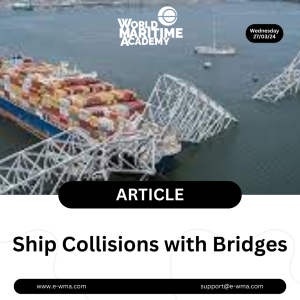A collision resulting in the destruction of a bridge and loss of life would trigger a complex legal aftermath involving criminal investigations, civil litigation, environmental assessments, and regulatory scrutiny.
A collision resulting in the destruction of a bridge and loss of life would trigger a complex legal aftermath involving criminal investigations, civil litigation, environmental assessments, and regulatory scrutiny. Stakeholders involved in such incidents must be prepared to navigate these legal challenges while prioritizing accountability, restitution for victims, and measures to prevent similar tragedies in the future.
In summary
while technical errors of the ship may be a contributing factor in collisions with bridges, legal precedent emphasizes the overarching duty of vessel owners to ensure the proper maintenance and operation of their vessels to prevent accidents and protect public safety. Ship collisions with bridges present complex legal challenges, requiring careful examination of liability, legal precedents, and regulatory compliance. By understanding the factors contributing to such incidents and the corresponding legal principles, stakeholders can work towards preventing collisions and mitigating risks in maritime navigation. Effective communication, adherence to regulations, and a commitment to safety are paramount in safeguarding both infrastructure and human lives in our interconnected maritime environment.
Legal precedents in cases
Ship collisions with bridges represent a complex and often contentious area of maritime law. These incidents can result in significant damage to both infrastructure and vessels, posing risks to human life and the environment. When such collisions occur, legal issues regarding liability, negligence, and regulatory compliance come to the forefront.
In this article, we will explore into the legal intricacies surrounding ship collisions with bridges, examining key factors, potential liabilities, and legal precedents.
Determining Liability
Determining liability in cases of ship collisions with bridges involves a thorough analysis of the circumstances leading up to the incident. Typically, multiple parties may share responsibility, including the ship’s crew, the bridge operators, port authorities, and even third-party entities responsible for maintenance or navigation assistance.
The crew’s actions, including navigation decisions, adherence to maritime regulations, and response to communication and warnings, are critical factors in determining liability. Negligence or errors in judgment on the part of the crew can contribute to collisions with bridges.
The proper operation and maintenance of bridges, as well as the implementation of effective communication and navigation protocols, are essential responsibilities of bridge operators and port authorities. Failure to maintain safe clearance heights, provide adequate warnings, or respond appropriately to vessel traffic can result in liability.
In some cases, third-party entities may be liable for ship collisions with bridges. For instance, if a navigation assistance service provides inaccurate or misleading information to the ship’s crew, contributing to the collision, they may share liability.
Legal precedents in cases
of ship collisions with bridges provide valuable guidance in navigating similar disputes. Courts often consider factors such as adherence to maritime regulations, the duty of care owed by all parties involved, and the foreseeability of the collision.
One notable legal precedent is the case of The Kota Tenaga. In this case, the vessel collided with a bridge due to errors in navigation and miscommunication between the ship’s crew and bridge operators. The court held both parties partially liable, emphasizing the importance of effective communication and adherence to established protocols.
Another relevant precedent is the Bayou Chico case, where a vessel collided with a bridge during adverse weather conditions. Despite the challenging circumstances, the court found the ship’s crew negligent for failing to adjust their navigation strategy accordingly, highlighting the duty of care owed by vessel operators.
General Legal Considerations
If a bridge is destroyed in a collision involving a ship, resulting in fatalities among individuals on the bridge, the legal implications become even more serious and multifaceted. Such an incident would likely trigger investigations by maritime authorities, law enforcement agencies, and potentially even national security organizations, depending on the circumstances surrounding the collision.
The legal considerations in this scenario would extend beyond issues of liability for property damage to encompass criminal liability for loss of life, potential environmental repercussions, and civil claims for wrongful death and personal injury.
Criminal Liability: If the collision and subsequent destruction of the bridge resulted from criminal acts such as intentional misconduct, gross negligence, or recklessness on the part of the ship’s crew or other parties, criminal charges could be pursued. Prosecutors would investigate whether the actions leading to the collision constituted offenses such as manslaughter, criminal negligence, or violations of maritime laws and regulations.
Wrongful Death and Personal Injury Claims: The families of individuals who lost their lives in the bridge collapse would likely pursue wrongful death claims against parties deemed responsible for the collision. Additionally, survivors who sustained injuries in the incident could file personal injury claims seeking compensation for medical expenses, lost income, pain and suffering, and other damages. These civil claims would involve complex legal proceedings to establish liability, quantify damages, and allocate responsibility among multiple parties.
Environmental Consequences: A collision resulting in the destruction of a bridge could have significant environmental consequences, particularly if hazardous materials or pollutants were released into the surrounding waterway. Environmental agencies would assess the impact of the incident on water quality, wildlife habitats, and ecosystems, and may pursue enforcement actions against parties responsible for environmental damage or pollution cleanup.
Regulatory Compliance and Oversight: Following a catastrophic collision, regulatory authorities would conduct comprehensive reviews of the incident to identify any regulatory violations or deficiencies in safety protocols. This could lead to enforcement actions, such as fines or license suspensions, against ship operators, bridge authorities, or other entities found to be non-compliant with applicable regulations.
If a bridge is destroyed in a collision involving a ship, resulting in fatalities among individuals on the bridge
the legal implications become even more serious and multifaceted. Such an incident would likely trigger investigations by maritime authorities, law enforcement agencies, and potentially even national security organizations, depending on the circumstances surrounding the collision.
The legal considerations in this scenario would extend beyond issues of liability for property damage to encompass criminal liability for loss of life, potential environmental repercussions, and civil claims for wrongful death and personal injury.
Criminal Liability: If the collision and subsequent destruction of the bridge resulted from criminal acts such as intentional misconduct, gross negligence, or recklessness on the part of the ship’s crew or other parties, criminal charges could be pursued. Prosecutors would investigate whether the actions leading to the collision constituted offenses such as manslaughter, criminal negligence, or violations of maritime laws and regulations.
Wrongful Death and Personal Injury Claims: The families of individuals who lost their lives in the bridge collapse would likely pursue wrongful death claims against parties deemed responsible for the collision. Additionally, survivors who sustained injuries in the incident could file personal injury claims seeking compensation for medical expenses, lost income, pain and suffering, and other damages. These civil claims would involve complex legal proceedings to establish liability, quantify damages, and allocate responsibility among multiple parties.
Environmental Consequences: A collision resulting in the destruction of a bridge could have significant environmental consequences, particularly if hazardous materials or pollutants were released into the surrounding waterway. Environmental agencies would assess the impact of the incident on water quality, wildlife habitats, and ecosystems, and may pursue enforcement actions against parties responsible for environmental damage or pollution cleanup.
Regulatory Compliance and Oversight: Following a catastrophic collision, regulatory authorities would conduct comprehensive reviews of the incident to identify any regulatory violations or deficiencies in safety protocols. This could lead to enforcement actions, such as fines or license suspensions, against ship operators, bridge authorities, or other entities found to be non-compliant with applicable regulations.
USA case law
In cases where a vessel collides with a bridge due to technical errors of the ship, legal precedent and case law offer valuable insights into liability and legal outcomes. While each case is unique and subject to its own set of circumstances, several notable precedents highlight the legal principles applied in such situations.
One relevant case is that of United States v. Reliable Transfer Co., Inc. (1975). In this case, a vessel collided with a bridge due to a malfunction in its steering system. The court held the vessel owner liable for negligence, emphasizing the duty to maintain and operate the vessel in a seaworthy condition. Despite the technical nature of the error, the vessel owner was deemed responsible for ensuring the proper functioning of essential equipment to prevent collisions.
Similarly, in Antilles Shipping Co. v. S.S. Antilles Reefer (1977), a vessel collided with a bridge after experiencing engine failure. The court found the vessel owner negligent for failing to maintain the vessel’s engines adequately, leading to the collision. This case underscores the importance of regular maintenance and inspection of essential ship systems to prevent technical failures that could result in collisions with bridges.
Additionally, in Canal Barge Co. v. Torco Oil Co. (1980), a vessel collided with a bridge due to a combination of factors, including technical errors in the vessel’s navigation equipment and miscommunication between the vessel’s crew and the bridge operator. The court attributed liability to both the vessel owner and the bridge operator, highlighting the shared responsibility for ensuring safe navigation and communication.
These cases illustrate that while technical errors of the ship may contribute to collisions with bridges, vessel owners are ultimately responsible for maintaining the vessel in a seaworthy condition and taking appropriate measures to prevent accidents. Legal outcomes in such cases often hinge on factors such as the foreseeability of the technical error, adherence to industry standards, and the extent of negligence or fault on the part of the vessel owner and other involved parties.
Further Reading
Shi, Tong-Ya and Jia, En-Shi and Zheng, Yuxuan and Wang, Huang-Ran and Yang, Li-Ming and Liu, Jun and Zhou, Feng-Hua and Wang, Yonggang, An Intelligent Flexible Arresting System for Protecting Bridges Over Non-Navigable Water Against Ship Collisions. Available at SSRN: https://ssrn.com/abstract=4552014 or http://dx.doi.org/10.2139/ssrn.4552014














